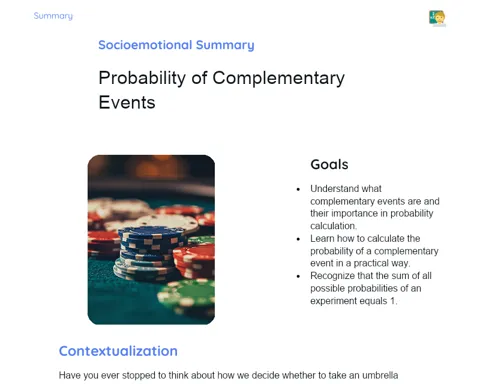TOPICS
Keywords
- Combinatorial Analysis
- Combination
- Arrangement
- Permutation
- Factorial
- Order
- Element
- Set
- Selection
Key Questions
- What differentiates combination from permutation and arrangement?
- How to calculate the number of possible combinations in a set?
- Why does the order of elements not matter in combinations?
- When to apply the combination formula in practical problems?
Crucial Topics
- Understanding the difference between combination, permutation, and arrangement.
- Correct application of the combination formula.
- Recognition of scenarios where the order of elements is not relevant.
- Ability to identify the number of elements and the size of the groups to calculate combinations.
Formulas
- Factorial (n!): Represents the product of all positive natural numbers up to n. Example: 4! = 4 × 3 × 2 × 1 = 24.
- Combination Formula:
C(n, k) = n! / [k! × (n-k)!]
where:
n: total number of elements in the set.k: size of the group to be formed.C(n, k): number of possible combinations of n elements taken k at a time.
NOTES
Key Terms
- Combinatorial Analysis: Branch of mathematics that deals with the counting, arrangement, and combination of elements in sets.
- Combination: Selection of elements from a set where order is not important.
- Factorial: Mathematical operation used to calculate the product of all positive integers from 1 up to a number n.
Main Ideas and Concepts
- Irrelevant Order: In combinations, the order of selected elements does not alter the result.
- Identification of Sets: Recognizing the total set of elements (n) and the number of elements we want to select (k).
- Practical Application: Use of combinations to solve lottery problems, grouping of people, distribution of objects, among others.
Topic Contents
- Difference between Combination, Permutation, and Arrangement:
- Combination does not consider the order of selected elements.
- Permutation deals with the order of elements and is used when all elements are used.
- Arrangement takes into account the order and is used when only part of the elements is used.
- Use of Factorial in the Combination Formula: The factorial represents the multiplication of a sequence of decreasing numbers down to 1 and is crucial for calculating combinations.
- Calculation of Combinations: The formula C(n, k) provides the number of possible combinations when choosing k elements from a set with n elements.
Examples and Cases
- Example of Committee Selection: How to select a group of 3 people from a total of 10 to form a committee without considering the order?
- We calculate C(10, 3) using the combination formula.
- C(10, 3) = 10! / (3! × (10-3)!) = 120.
- There are 120 different ways to form the committee.
- Example of Arranging Books on a Shelf: If we have 5 books and want to know how many different ways 3 can be chosen to arrange on a shelf, we use combination since order does not matter.
- C(5, 3) = 5! / (3! × (5-3)!) = 10.
- There are 10 possible ways to select the 3 books.
SUMMARY
Summary of Key Points
- Combination: Select groups where order does not matter, only who is part of the group.
- Combination Formula: C(n, k) = n! / [k! × (n-k)!], an essential tool to calculate the number of ways to select k elements from a set of n elements.
- Factorial: Understood as the product of all positive integers up to a given number (n!), it is a key element in the calculation of combinations.
- Practical Application: Crucial area for solving selection problems where the order of selected elements does not affect the result.
- Differentiation: Distinguishing combinations from arrangements and permutations, where the order of elements is significant.
Conclusions
- The order of elements in a combination does not alter its result, unlike permutations and arrangements.
- Calculating combinations is a valuable mathematical skill to solve a variety of practical problems.
- Correctly identifying n (total elements) and k (group size) is crucial to apply the combination formula properly.
- In practice, combinations are used in situations such as team formation, selection of subsets, lotteries, and many other scenarios.



